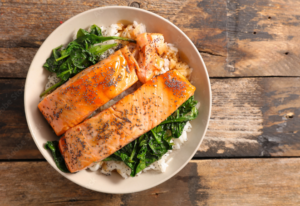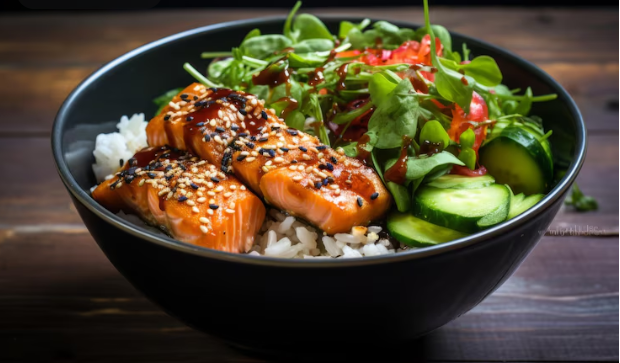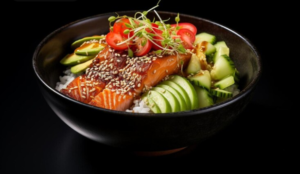Introduction to Teriyaki Salmon Bowls
Teriyaki Salmon Bowl blend Japanese teriyaki sauce with nutritious salmon and colorful vegetables. This popular dish balances delicious flavors with health benefits, making it a favorite for both taste and wellness.
Overview of Teriyaki Salmon Bowls
Typically, a Teriyaki Salmon Bowl includes steamed rice topped with salmon fillet and a sweet, tangy teriyaki sauce. Vegetables like broccoli, bell peppers, and carrots add crunch and color. The dish is nutritious, visually appealing, and provides a balanced meal.
Popularity and Cultural Relevance
The global rise of Japanese cuisine has made Teriyaki Salmon Bowls popular, especially among health-conscious diners. In the West, these bowls fit well in fast-casual dining and are easy to customize at home. The dish represents a fusion of traditional Japanese flavors and modern dietary preferences, maintaining its cultural roots while adapting to contemporary tastes.
Ingredients and Preparation
Creating a Teriyaki Salmon Bowl involves a combination of fresh ingredients and a few culinary techniques that together bring out the best of each component. Here’s what you need and how to prepare this delightful dish.
Essential Ingredients for Teriyaki Salmon Bowl
To make a Teriyaki Salmon Bowl, you will need the following ingredients:
- Salmon fillets: opt for fresh, skin-on salmon for the best flavor and texture.
- Rice: White sushi rice or brown rice for a healthier option.
- Vegetables: Broccoli florets, sliced bell peppers, and shredded carrots are commonly used.
- Teriyaki sauce: Store-bought or homemade.
- Garnishes: Sesame seeds and sliced green onions for topping.
- Oil: For cooking, such as sesame or vegetable oil.
Step-by-Step Preparation Guide
- Cook the Rice:
- Rinse the rice until the water runs clear. Cook according to package instructions until it’s fluffy and tender.
- Prepare the Vegetables:
- Steam the broccoli florets until bright green and tender. Sauté bell peppers and carrots in a skillet with a little oil until they are just softened.
- Cook the Salmon:
- Season the salmon fillets with salt and pepper. Heat oil in a skillet over medium-high heat and place the salmon skin-side down. Cook for about 6-7 minutes on one side until the skin is crisp. Flip over and cook for an additional 3-4 minutes.
- Assemble the Bowl:
- Spoon the cooked rice into bowls. Top with cooked vegetables and the salmon fillet. Drizzle with teriyaki sauce and sprinkle sesame seeds and green onions on top.
Homemade Teriyaki Sauce Recipe
To make your own teriyaki sauce, you’ll need:
- Soy sauce: 1/2 cup
- Water: 1/4 cup
- Brown sugar: 2 tablespoons
- Garlic: 1 minced clove
- Ginger: 1 teaspoon of grated ginger
- Cornstarch slurry: 1 tablespoon cornstarch mixed with 2 tablespoons water
Procedure:
- Combine soy sauce, water, brown sugar, garlic, and ginger in a small saucepan. Bring to a simmer over medium heat.
- Add the cornstarch slurry to the saucepan, whisking continuously. Cook for about 2-3 minutes until the sauce thickens.
- Remove from heat and let it cool. Use immediately or store in the refrigerator for later use.
This guide provides a detailed overview of making a Teriyaki Salmon Bowl, from the ingredients you need to the steps to put it all together. Whether you choose to use store-bought teriyaki sauce or make your own following the recipe above, you’ll end up with a delicious and satisfying meal.

Nutritional Information
Understanding the nutritional benefits of the Teriyaki Salmon Bowl helps highlight why this dish is not just delicious but also a healthy choice. Here’s a look at the key nutritional aspects of the main ingredient, salmon, along with a general breakdown of the dish’s caloric content.
Health Benefits of Salmon
Salmon is renowned for its health benefits, primarily due to its high content of omega-3 fatty acids. These essential fats are crucial for heart health, as they help reduce inflammation, lower blood pressure, and decrease risk factors for diseases. Additionally, salmon is a great source of protein, which is vital for muscle repair and growth. It also provides significant amounts of vitamin D, selenium, and B vitamins, which support energy production, immune function, and bone health.
Caloric Content and Nutritional Breakdown
A typical Teriyaki Salmon Bowl consists of the following components and their approximate nutritional contributions:
- Salmon: A 4-ounce serving of cooked salmon contains about 200 calories, 25 grams of protein, and 12 grams of fat, including beneficial omega-3 fatty acids.
- Rice: One cup of cooked white rice has about 200 calories, primarily from carbohydrates, with small amounts of protein and negligible fat.
- Vegetables: A mix of broccoli, carrots, and bell peppers adds about 100 calories per cup, packed with dietary fiber, vitamins A and C, and potassium.
- Teriyaki Sauce: Depending on the recipe, about 2 tablespoons can range from 40 to 100 calories, largely from sugars and soy sauce.
Overall, a full bowl might range between 500 to 600 calories, making it a moderate-calorie meal that is nutritionally dense. This meal provides a good balance of macronutrients along with essential vitamins and minerals, making it a healthy option for a fulfilling meal that supports various dietary needs.
Cooking Techniques and Tips
Mastering the cooking techniques for the key components of a Teriyaki Salmon Bowl enhances both the flavor and texture of the dish. Here are expert tips for preparing salmon and roasting broccoli, ensuring each bite is delicious.
Best Practices for Cooking Salmon
- Choose the Right Cut: Opt for fresh salmon fillets with the skin on, as the skin helps the flesh hold together and adds crispiness when cooked.
- Bring to Room Temperature: Let the salmon sit out for 15-20 minutes before cooking. This ensures even cooking.
- Preheat the Pan: Use a heavy, non-stick skillet and preheat it on medium-high heat. A hot pan sears the salmon quickly, preventing sticking.
- Skin Side Down: Always start with the skin side down. Cook most of the way through on this side, which helps render the fat and crisp the skin.
- Don’t Overcook: Salmon cooks quickly, usually 4-6 minutes per side depending on thickness. The center should be slightly translucent when done.
- Rest Before Serving: Let the salmon rest for a few minutes after cooking to redistribute the juices.
Tips for Perfect Roasted Broccoli
- Preheat the Oven: Start with a hot oven (around 425°F or 220°C) to ensure a good sear and crispy edges.
- Dry the Broccoli: Make sure the broccoli is completely dry after washing to avoid steaming in the oven.
- Cut Evenly: Chop the broccoli into uniform pieces for even cooking.
- Use Oil and Seasoning: Toss the broccoli with a little olive oil and season with salt, pepper, and other spices like garlic powder before roasting.
- Spread Evenly: Lay the broccoli in a single layer on a baking sheet. Crowding can cause steaming, which prevents browning.
- Roast Until Crisp: Roast for 20-25 minutes, flipping halfway through. The edges should be crispy and lightly charred.
By following these techniques, you can ensure that every component of your Teriyaki Salmon Bowl is cooked to perfection, enhancing the overall flavor and texture of the meal.
Serving and Presentation
The appeal of a Teriyaki Salmon Bowl not only lies in its taste but also in its presentation. Aesthetically pleasing plating can enhance the dining experience by appealing to the senses. Here are some techniques for plating and suggestions for accompaniments and garnishes that will make your Teriyaki Salmon Bowl visually appealing and even more delicious.
Plating Techniques for a Beautiful Presentation
- Choose the Right Bowl: Use a wide, shallow bowl to showcase all ingredients without overcrowding.
- Layer Thoughtfully: Start with a base of rice, smoothing it out to create a flat surface. This acts as the canvas for your dish.
- Arrange the Salmon: Place the salmon fillet in the center of the bowl, showcasing the beautifully cooked, crispy skin.
- Add Vegetables Strategically: Arrange the vegetables around the salmon in groups. This not only creates a vibrant color palette but also allows diners to taste individual elements or mix as they like.
- Drizzle Sauce Artfully: Spoon teriyaki sauce over the salmon and lightly around the bowl for a glossy finish. Use a squeeze bottle for more precise application if available.
Accompaniments and Garnishing Ideas
- Garnishes: Sprinkle sesame seeds over the salmon for a subtle crunch and visual appeal. Green onions or chives can be sprinkled on top for a fresh, vibrant look and flavor.
- Side Dishes: Offer a side of miso soup or a seaweed salad to complement the main dish and add variety to the meal.
- Condiments: Provide small dishes of extra teriyaki sauce or wasabi on the side for those who appreciate a flavor boost.
- Herbs: A sprig of cilantro or parsley can add a touch of green and fresh flavor contrast to the savory components.
With these serving and presentation tips, your Teriyaki Salmon Bowl will not only taste great but also turn into a feast for the eyes, making the meal a more enjoyable and satisfying experience.
Variations of Teriyaki Salmon Bowl
The versatility of the Teriyaki Salmon Bowl allows for numerous adaptations, catering to various dietary preferences and needs. Whether you’re looking for alternative proteins, different vegetables, or specific dietary options like low-carb and vegan, there are plenty of ways to customize this dish.
Alternative Proteins and Vegetables
- Protein Variations:
- Chicken: Marinate chicken thighs or breasts in teriyaki sauce, then grill or bake until fully cooked. Slice and serve as you would with the salmon.
- Beef: Thinly slice beef steak or use ground beef with teriyaki sauce for a richer flavor profile.
- Tofu: For a vegetarian option, cube firm tofu and marinate in teriyaki sauce. Bake or sauté until crispy on the outside.
- Shrimp: Quick and easy to cook, shrimp makes a delightful addition to the bowl when tossed in teriyaki sauce.
- Vegetable Variations:
- Snap Peas and Mushrooms: Add snap peas and sliced mushrooms for a different texture and earthy flavors.
- Spinach and Kale: Incorporate greens like spinach or kale for added nutrients and a touch of color.
- Sweet Corn and Avocado: Sweet corn kernels and sliced avocado add sweetness and creaminess, enhancing the overall mouthfeel.
Low-Carb and Vegan Options
- Low-Carb Alternatives:
- Cauliflower Rice: Replace traditional rice with cauliflower rice for a low-carb base that’s equally satisfying and lighter.
- Zucchini Noodles: Spiralized zucchini provides a refreshing and crunchy alternative to rice, significantly reducing the carbohydrate content.
- Leafy Greens: Use a bed of mixed leafy greens like romaine or baby spinach instead of rice for an ultra-low-carb salad version.
- Vegan Adaptations:
- Tofu or Tempeh: Use tofu or tempeh as the protein base, marinating and cooking it as you would with salmon to keep the authentic teriyaki flavor.
- Vegan Teriyaki Sauce: Ensure the teriyaki sauce is vegan by using a honey substitute like maple syrup or agave nectar in the sauce recipe.
- Vegan Garnishes: Top with vegan-friendly garnishes such as crushed peanuts or cashews instead of sesame seeds, and use vegan mayo or sriracha for extra spice.
These variations not only cater to different dietary needs but also add an exciting twist to the traditional Teriyaki Salmon Bowl, making it a flexible dish suitable for any occasion or preference.
Storage and Leftovers
Proper storage and reheating are key to enjoying Teriyaki Salmon Bowl leftovers without losing flavor or texture. Here are some best practices to ensure your leftovers remain as delicious as when they were first made.
Best Practices for Storing Leftovers
- Cool Quickly: Allow your leftover Teriyaki Salmon Bowl to cool to room temperature within two hours of cooking to prevent bacterial growth.
- Separate Components: If possible, store the salmon, vegetables, and rice separately in airtight containers. This helps maintain the texture and flavor of each component.
- Use Airtight Containers: Store the leftovers in airtight containers to keep out moisture and other contaminants. This also helps prevent the flavors from mingling too much in the fridge.
- Refrigeration: Refrigerate leftovers promptly. Properly stored, they can last up to three days in the refrigerator.
- Label Containers: It’s helpful to label your containers with the date of storage to keep track of how long they’ve been in the fridge, ensuring they are used within a safe time frame.
Reheating Without Losing Flavor
- Reheat Gently: To maintain the best flavor and texture, reheat salmon and vegetables separately. Use a low heat setting on the stove or a moderate temperature in the microwave.
- Add Moisture: Sprinkle a few drops of water or add a small amount of teriyaki sauce over the rice and vegetables before reheating to prevent them from drying out.
- Cover While Microwaving: If using a microwave, cover the food with a microwave-safe lid or paper towel. This helps steam the food, evenly reheating it without drying it out.
- Avoid Overheating: Heat just until the food is warm enough to eat. Overheating, especially salmon, can make it tough and dry.
- Use the Oven for Crisping: If you want to restore some of the crispiness to the salmon skin, reheat it in the oven at 350°F (175°C) for about 10 minutes or until just heated through.
Following these storage and reheating tips will help ensure that your Teriyaki Salmon Bowl leftovers are just as enjoyable the second time around, preserving their flavors and textures optimally.
FAQs
Addressing common questions can help clarify doubts and provide additional information that enhances the understanding and enjoyment of Teriyaki Salmon Bowls. Here are answers to some frequently asked questions:
Can You Eat Salmon Skin?
Yes, salmon skin is edible and can be quite nutritious. It contains a higher concentration of omega-3 fatty acids than the flesh and, when cooked until crispy, it adds a delightful texture to dishes. Ensure the salmon is well-cleaned and cooked to a safe temperature. When crisped up, it provides a nice contrast to the soft textures of the other bowl components.
How to Make the Bowl Low Sodium?
To make a Teriyaki Salmon Bowl with low sodium, consider the following adjustments:
- Use Low-Sodium Soy Sauce: Replace regular soy sauce in your teriyaki sauce with a low-sodium version to drastically reduce the overall sodium content.
- Make Your Own Teriyaki Sauce: By preparing your own sauce, you can control the amount of salt and use salt substitutes like potassium chloride.
- Rinse Canned Vegetables: If using canned vegetables, rinse them thoroughly under cold water to remove excess sodium.
- Choose Fresh Ingredients: Opt for fresh or frozen vegetables instead of canned, and use fresh salmon rather than pre-marinated or processed versions.
External Links and Recommended Anchor Text
Here are some external links related to Teriyaki Salmon Bowl recipes:
- Teriyaki Salmon Sushi Bowl Recipe – My Gluten Free Guide
This recipe features gluten-free teriyaki salmon served on sushi rice with edamame beans and avocado, making it not only healthy but also easy to prepare. - Teriyaki Salmon Bowl | Healthy Meal Prep Recipe – YouTube
A video recipe detailing how to prepare an easy and healthy teriyaki salmon bowl, ideal for meal prep. - Teriyaki Salmon Bowls | My Sugar Free Kitchen
This recipe focuses on a healthier take on the teriyaki salmon bowl with a sweet, salty, and tangy sauce, served with broccoli and edamame. - Easy Teriyaki Salmon Bowls – Real Food by Dad
Offers a simple teriyaki salmon bowl recipe that combines flavorful ingredients like smoked paprika and brown sugar for a unique twist.


